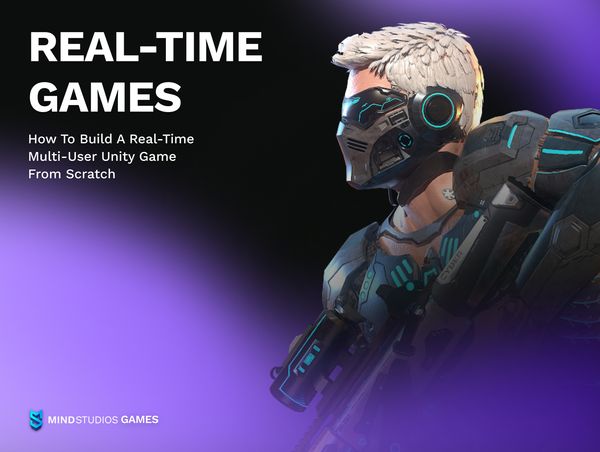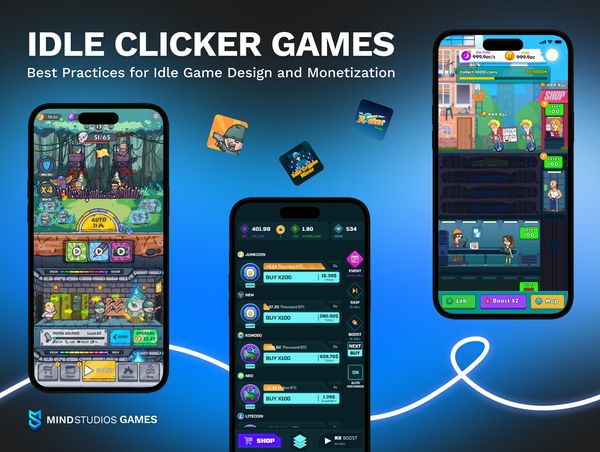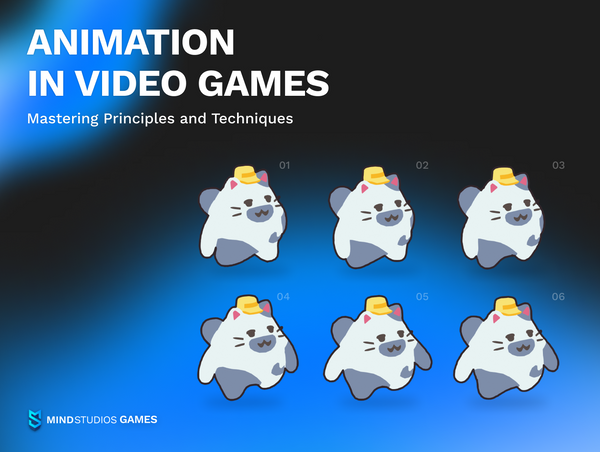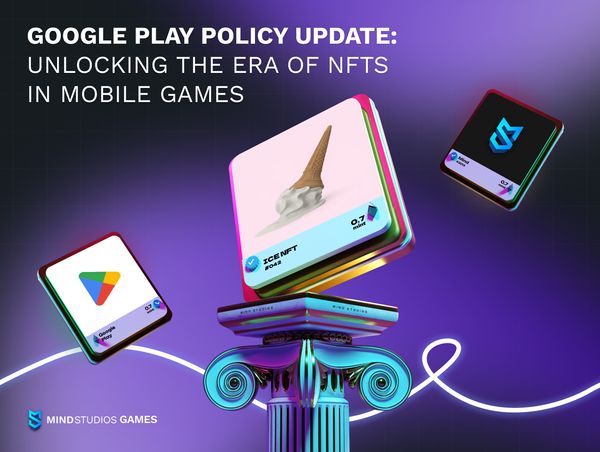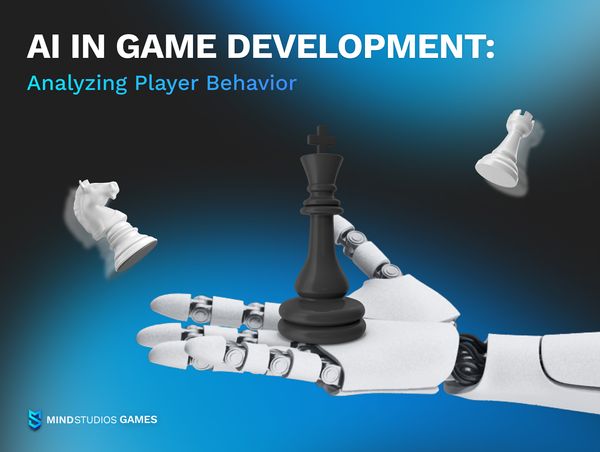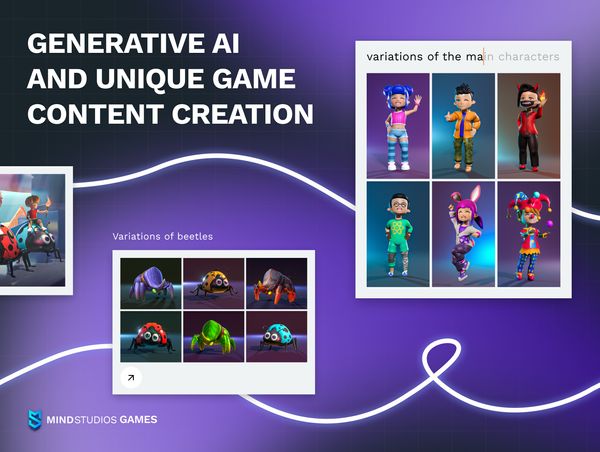
Generative AI is the buzzword of the latest couple of years, and based on what we’re observing so far, it’s not one of the technologies that fade into oblivion quietly and cease to evolve. In fact, the evolution of generative AI is rapid and loud. We can’t help but talk about it.
With this article, we’ll be focusing on separate aspects of using AI in game development. We’ll start by exploring the most talked about side of AI — the generative kind.
To obtain a broader view, check our previous guide on Enhancing Mobile Game Experiences with AI.
AI techniques for content generation
Content is the heart of game design. From playable characters and narrative to levels, NPCs, drops, and the world itself is considered content. It’s obviously a huge amount of creative data to generate. Which is why more and more developers are turning to AI for game generation, in part or even in full — to create more diverse games faster.
Depending on the type of content you need, different techniques are used. In the table below, we’ll highlight the most popular ones and for what content they’re used.
Procedural content generation (PCG) algorithms
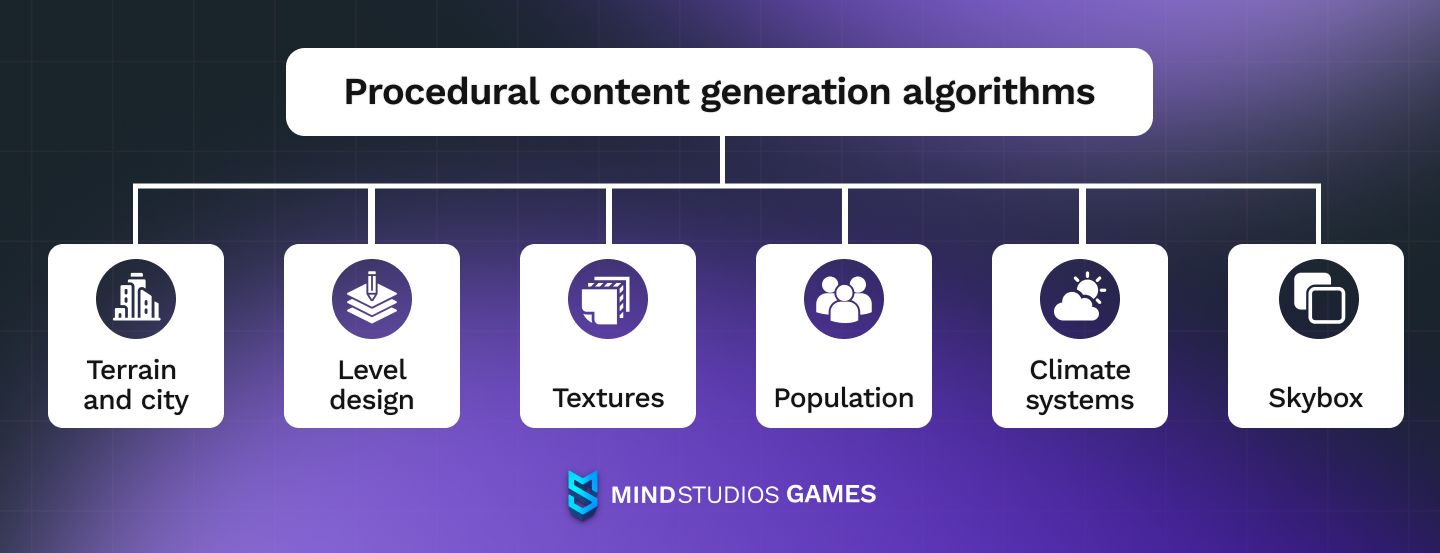
Procedural content is the largest and most varied part of all the game content. While it’s comprised of what seems to be very simple pieces, overall it makes the game what it is: its levels, landscapes, assets, and events.
The techniques for PCG are used for:
Terrain and city generation
Terrain features like elevation and slopes, terrain content like rivers and forests can be generated mathematically by an algorithm. A good example here would be Minecraft — the famous title uses algorithms for procedural content generation, initializing terrain from a seed algorithm. Although there’s no AI involved in this game yet, the potential for its use in similar circumstances is already being explored.
The same technique can also be used to create urban agglomerations like towns and cities. Instead of manually creating a plan for streets and roads, using artificial intelligence in game design (specifically, it’s part of level design) here would make it easier, faster, and will add a touch of randomness.
Level design
Traditionally, each level in a game is meticulously crafted by a level designer (or a game designer in smaller game companies). This includes difficulty adjustment, level rewards, obstacles, etc. With PCG, designers can speed up their process by having an algorithm to create new levels. They just need to set up rules and parameters for gradual changes. If the algorithm is dynamic, it’s even possible to generate levels randomly for the player, meaning even if the player decides to replay the level, it won’t be completely the same. The latter option is especially useful for platformer, IO, idle, and hyper-casual games.
Texture generation
Instead of creating each texture in the game manually, artists can employ algorithms called Generative Adversarial Networks (GANs). These algorithms can use visual techniques to generate textures that look both realistic and random while actually being AI-generated (i.e., mathematically calculated and machine-made).
GANs can also generate other simple assets for your game besides textures, thus lessening the load on artists and freeing their time to work on more complex graphics.
Population generation
Same as with terrain and urban area generation, an algorithm can create populations of non-interactable assets (people or creatures of other kinds) that behave in a human-like manner. The latter is achieved by utilizing techniques like Swarm AI and the like.
Climate systems
If you want to enrich your game with changeable weather and multiple climate zones, it makes sense to employ AI for that. An algorithm can work out and help implement what will look to a player like an unpredictable change, which will enrich the playing experience.
Skybox generation

[Source: Skybox AI]
Skybox is a technique used to make backgrounds seem bigger than they actually are by rendering around the scene. Basically, artists enclose the scene in a cuboid so that players could see a seamless scenery even when turning a camera. This way, the level appears wider and more complex.
Services like Skybox AI from Blokade Labs offer an algorithm for skybox generation based on textual prompts.
AI agents for NPC behavior generation
AI agent is a system of algorithms able to autonomously perceive the surrounding environment and align its actions and decisions based on its goals and this environment data. Sounds complex, right? It is. But it’s manageable with the help of experienced game developers.
The most straightforward way to use AI agents in game development is to generate content for NPCs and their interaction with players. To do that, developers employ machine learning algorithms and neural networks as well as a variety of other techniques, such as:
- Decision tree
- Reinforced learning
- Fuzzy logic
Agents can be reactive — taking action only as a reaction to a trigger (e.g., player’s actions); or they can be proactive — making plans on optimal ways to reach their pre-set goals ahead of triggers.
Basically, AI agents are what makes NPCs evolvable and unique, to a certain degree.
Natural language processing (NLP)
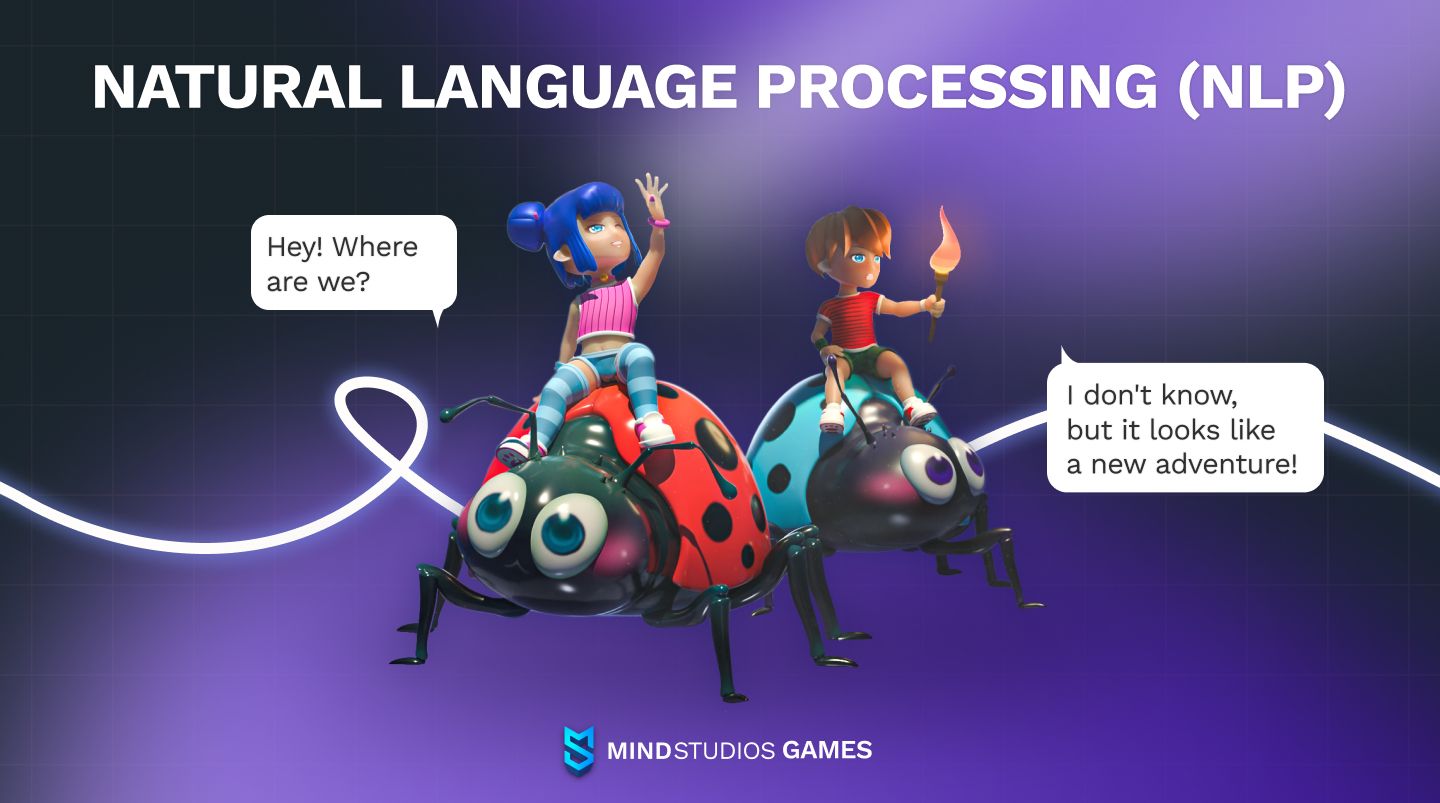
When we’re talking about NLP in the context of generative AI in game design, we’re primarily talking about dialog systems for players’ interaction with NPCs. Using NLP-based algorithms makes it possible to create NPCs that are more human-like and can react to each player’s text or voice input in a natural way.
So instead of having the player choose from pre-existing dialog options, you can offer immersion by allowing them to write or speak to the characters with their own words.
Upscaling
This is the technique to improve detalization of imagery in a variety of conditions, utilizing mostly data from high-resolution photos. It is used for textures and to make it possible to zoom in to the game’s visual content without suffering quality loss or burdening artists with drawing in resolutions hardly necessary for anything but detailed textures.
Procedural animation
Same as upscaling uses high-res photos to improve the quality of textures while saving artists’ time, the procedural generation of animation uses motion synthesis to quickly animate objects realistically, based on laws of physics.
Benefits of utilizing generative AI in game content
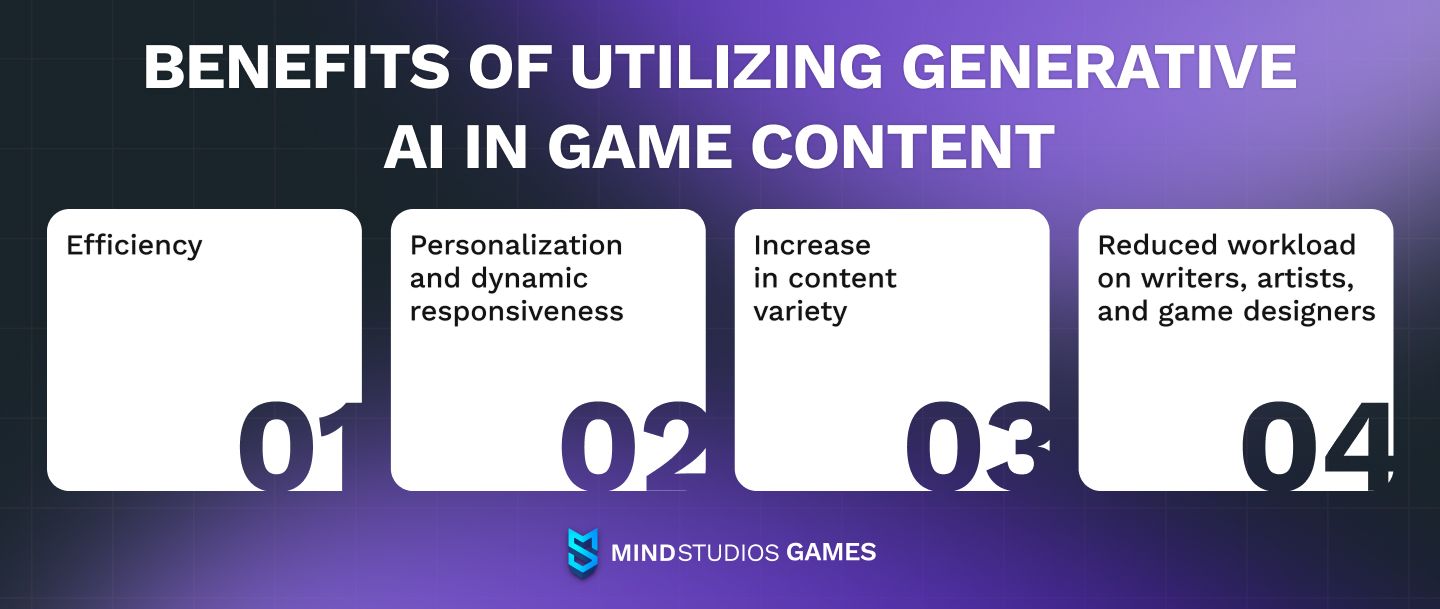
Since the boom caused by ChatGPT, Midjourney, and the like, game development teams everywhere has been tapping into the opportunities this tech could offer. Multiple generative AI services popped out for text and image creation, and big corporations have been introducing their own AI assistant tools.
Now, what does AI bring to the table that makes it so alluring to big and small game development teams alike?
Here are top 4 generative AI benefits for game content creators.
Efficiency |
Undeniably, algorithms collect, analyze, and generate data faster than a human physically can. It takes a service like Ludo.ai mere seconds to roll out a comprehensive answer to an inquiry asking for game niches that offer the biggest success opportunities. It would take at least a couple of days for a professional game designer to thoroughly analyze the market. The same goes for in-game content generation, like writing dialogs, offering ideas for plot progression, or creating game assets. It’s not going to be perfect from the get-go, but it can help creatives push past mental blocks, find inspiration, and speed up their work. |
Personalization and dynamic responsiveness |
Something a human game designer or content creator can’t do is monitor each player 24/7 and tweak content for each person separately, give out personalized offers for in-game purchases, or adjust NPC behavior based on the player’s character alignment. A generative AI can do that. Machines never eat or sleep, and with today’s technology, they can analyze each player’s progress on the go and provide incentives or assistance. |
Increase in content variety |
One of the reasons game AI development became such a popular topic is the fact that an algorithm can hold and take into account way more data than a conscious human brain can. Which means, essentially, that with proper training and monitoring, AI can generate content options that a single human might have not considered — for example, due to lack of personal experience on a specific topic. A person can’t have lived through all possible scenarios of being lost in a forest, or surviving on an uninhabited island after a ship wreck. An algorithm can analyze all the data available on the topic and summarize multiple options for possible actions in a specific situation. This helps game designers see more opportunities for progress and diversify players’ experiences. |
Reduced workload on writers, artists, and game designers |
Automation is at the heart of AI implementation, and this perk goes well with game development. By automating certain tasks — for example, application of textures or generation of simple repetitive assets — you can relieve your creatives from mundane and boring tasks. Instead, they’ll be able to focus more on fleshing out important parts of the game — designing main and supportive characters, refining the game plot, creating engaging events, etc. |
Challenges in AI-driven game content generation
The flip side of the content generation with artificial intelligence in game development is also not to be overlooked if you want your game to be of high quality and fins success. The main things any game developer needs to keep in mind when employing AI in their work are few, but it’s essential to pay attention to them.
Quality |
AI-generated in-game content faces three main challenges:
Generative AI algorithms as we see them now lack long-term memory retention, meaning they generate content anew after each input. This results in repetition and inconsistency, especially if the data fed to train the algorithm is vast and includes opposing opinions. Hence, creating somewhat long stories or dialogs might bring unsatisfactory results. Since the AI isn’t alive, its perception of “realism” is based on mathematical logic. However, stories we spin in games aren’t always logical, and neither are human actions. Therefore, AI-based content can fall short in this regard. This is also true to generative AI for art: you’ve probably heard about people with extra fingers 🙂 Finally, bias is a huge obstacle to AI, since this is one thing it can’t overcome on its own. If you don’t train the algorithm on diverse data, it won’t be able to produce inclusive content. |
Unpredictability |
This is simultaneously a blessing and a curse of AI content generation. On one hand, the randomness of algorithms can diversify player experiences and make it possible for replaying a game to seem like a completely new thing. On the other hand, though, not all randomness leads to good experiences. It’s necessary to fine-tune the algorithms to hold them within certain constraints so that your game isn’t ruined. |
Training time and necessary data |
This is mostly an issue when you wish to create content similar in style to what your creatives make. Be it art or text, to make the style consistent, you’ll have to train the algorithm. Some services already offer AI content generation based or user-provided content, but training takes a lot of diverse data and time to produce acceptable results. Meaning, creating a full game of good quality with AI only will be neigh impossible. |
Integration with handcrafted content |
Seamless integration of AI generated content with elements handcrafted by your artists and writers is crucial for maintaining a cohesive visual and narrative experience. Transitioning between generated and manually designed assets without noticeable differences requires careful consideration and design. |
The outlined challenges aren’t all that hard to overcome, though. What you need is to employ AI tools as what they are — tools. While AI generated games are indeed gaining more and more spread, a quality game requires a video game development team with human specialists at a core. Professionals are the one that can fine-tune your algorithms and sift through AI-generated content to use the good pieces and discard the bad ones.
Case studies and success stories
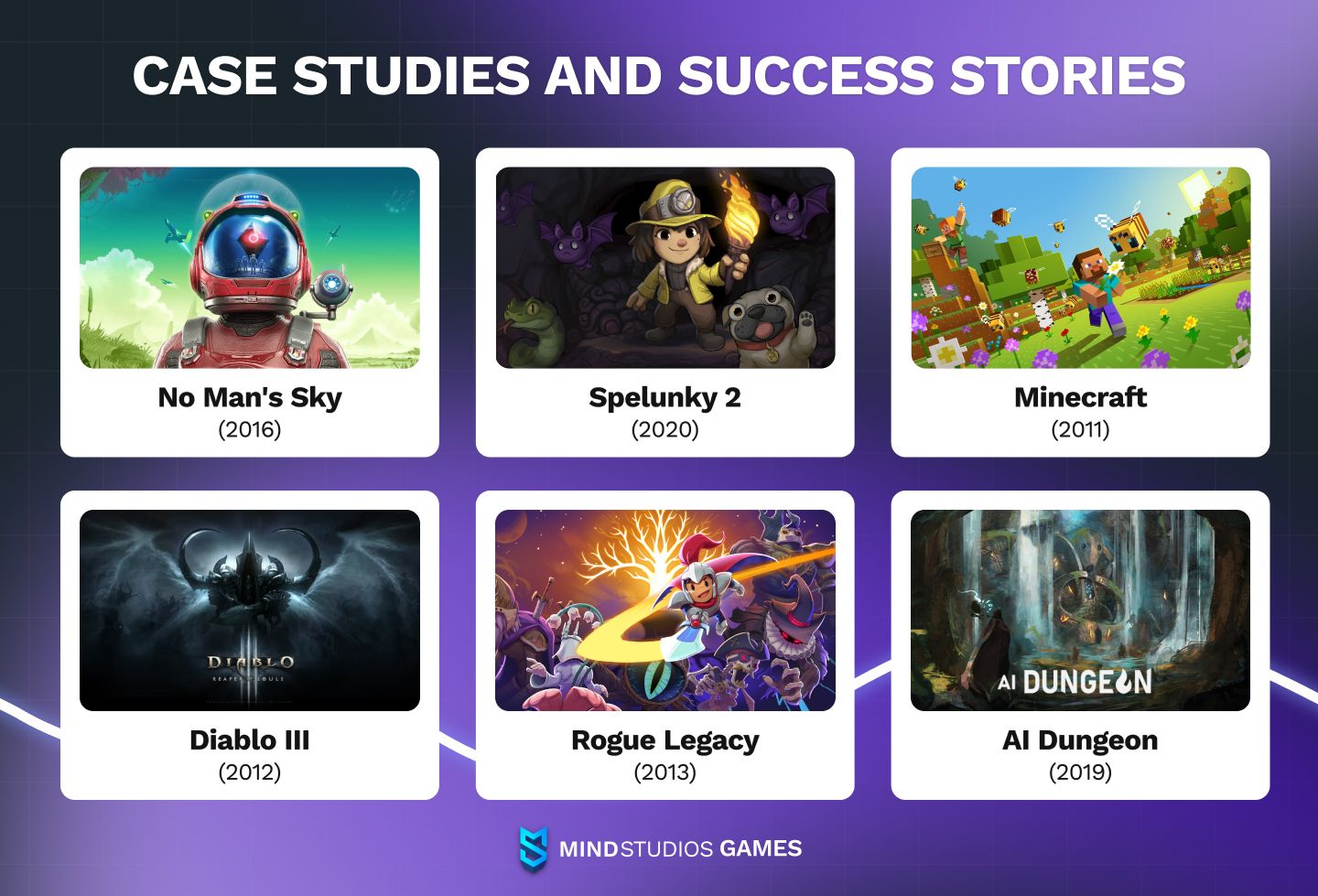
To this day, a number of video games have successfully employed generative AI techniques for content creation, and some of them did it quite some time ago. Here are the titles you might want to try if you’re curious.
No Man's Sky (2016)
No Man's Sky is an exploration-focused game with a procedurally generated universe. The game uses generative algorithms to create diverse landscapes, flora, and fauna on each planet. And since there are literally billions of planets, players get a vast and unique universe to explore.
Spelunky 2 (2020)
Spelunky 2, a roguelike platformer, employs procedural generation for its levels. Each time a player starts a new game, the levels are dynamically generated, offering a challenging and unpredictable experience. This approach enhances replayability and keeps the gameplay fresh.
Minecraft (2011)
Minecraft, a famous sandbox game, utilizes procedural generation for its world. The terrain, caves, and structures are generated algorithmically, creating a virtually infinite game world for players to explore, mine, and build in.
Diablo III (2012)
Diablo III uses procedural generation for its dungeons and levels. This approach ensures that each play-through offers new layouts, enemy placements, and challenges, contributing to the game's replayability.
Rogue Legacy (2013)
Rogue Legacy, another roguelike platformer, employs procedural generation for its castle layouts. Each time a player dies, a new castle is generated, with different room arrangements, enemy placements, and challenges. This creates a fresh experience with each attempt.
AI Dungeon (2019)
We mentioned this game in our previous article. AI Dungeon is an interactive text-based adventure game that uses natural language processing (NLP) and generative models to dynamically generate and respond to player input. The game's narrative evolves based on the player's choices, providing a highly dynamic and personalized experience.
Sable (2021)
Sable is an indie exploration game that utilizes procedural generation for its open-world environment. The game features a visually stunning, hand-drawn art style, and procedural generation ensures a vast and varied landscape for players to explore.
Conclusion
The use of generative AI in game content creation is continuously evolving, and new advancements and applications are emerging regularly. Generative AI tools are becoming an integral part of the game development toolkit, contributing to innovative and dynamic gaming experiences.
The most used application of generative AI in video game development today is for procedural content as the least obstacle-riddled field. However, we’re already seeing attempts at human-like interaction with NPCs and their in-game evolution, which was unimaginable just five years ago.
Mind Studios Games is a mobile game development company, and we’re truly excited to see this evolution. As this technology is becoming more and more widespread, it also inevitably becomes optimized for use in mobile games. We’ve already tried AI generation for one of our games — Beetle Riders — and we were quite fascinated with the results. We’re eager to try more complex and interesting applications. If you’re like us and artificial intelligence in game development is something you’d like to try, drop us a line for a consultation. Let’s climb this hill together 🙌🏻

